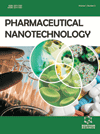- Home
- A-Z Publications
- Pharmaceutical Nanotechnology
- Previous Issues
- Volume 5, Issue 2, 2017
Pharmaceutical Nanotechnology - Volume 5, Issue 2, 2017
Volume 5, Issue 2, 2017
-
-
Oral Nano-Delivery Systems for Colon Targeting Therapy
More LessAuthors: Tianxu Zhang, Guanyin Zhu, Boyao Lu and Qiang PengBackground: Targeting drug delivery is an attractive research area, as it enables localized treatment, improves the efficacy of therapeutics and reduces systemic toxicity. Colon targeting delivery is particularly beneficial to the treatment of colon diseases, such as inflammatory bowel disease and colon cancer, due to the improved local drug concentrations. The traditional strategies for colon targeting delivery include time-dep Read More
-
-
-
Carbon Nanotubes in the Treatment of Skin Cancers: Safety and Toxic ological Aspects
More LessAuthors: Nida Akhtar and Kamla PathakBackground: Skin cancer is depicted to be the most common malignant disease across the globe that is frequently diagnosed in people bearing light skin. Three common forms of skin cancers are squamous cell carcinoma, basal cell carcinoma, and malignant melanoma. Treatment of skin cancers comprises of various forms of management strategies that can help in curing the disease including the use of several therapeut Read More
-
-
-
Investigation of the pH Dependent Cytotoxicity of Paclitaxel Conjugated Gold Nanoparticles
More LessAuthors: Zahrah Alhalili, Joe Shapter, Nur Hikmatul Auliya and Barbara SandersonbBackground: Breast cancer, apart from skin cancer, is the most common cancer among women accounting for nearly 1 in 3 cancers and the second leading cause of cancer-related death among women after lung cancer. Finding new approaches to treat such cancers is critically important. Objective: This work investigated the ability of a simple system based on paclitaxel conjugated gold nanoparticles (AuNP) to i Read More
-
-
-
PEGylated Liposomes of Meloxicam: Optimization by Quality by Design, in vitro Characterization and Cytotoxicity Evaluation
More LessAuthors: Jessy Shaji and Ipshita MenonBackground: Chemoprevention is a strategy which uses drugs which are traditionally not used as anti-cancer drugs; however, they prevent the carcinogenesis. Meloxicam (MLX) is traditionally used as a non-steroidal anti-inflammatory drug (NSAID), but it has been proven to have activity against colorectal cancer. Subsequently MLX seems to be a likely candidate to be utilized in the chemopreventive therapy of colorectal c Read More
-
-
-
Preparation, Optimization and Physicochemical Characterization of Aripiprazole Loaded Nano-porous in situ Forming Implant
More LessBackground: Multiple applications of antipsychotic agents are the main obstacle in the treatment of schizophrenia. Due to behavioral abnormalities, low compliance is observed in most of the psychotic patients. Designing of new drug delivery systems to overcome compliance problem seems to be necessary. In situ forming implants are a suitable choice for the delivery of antipsychotic agents due to their easy administration proc Read More
-
-
-
Antimicrobial, Biofilm Inhibitory and Anti-infective Activity of Metallic Nanoparticles Against Pathogens MRSA and Pseudomonas aeruginosa PA01
More LessAuthors: Jamuna B. Aswathanarayan and Ravishankar R. VittalBackground: The emergence of drug resistant pathogens is a major concern to the scientific community. Novel approaches such as the use of functionalized nanomaterials with antimicrobial activity is required to treat infectious diseases. Objective: In the present study, the metallic nanoparticles (iron, gold, zinc oxide and copper oxide) were evaluated for the antimicrobial, biofilm inhibitory and anti-infective activity Read More
-
-
-
Qualitative Estimation of Drug Entrapment Efficiency in Polymeric Nano - Micelles Using Dissipative Particle Dynamics (DPD)
More LessAuthors: Farzin Hadizadeh and Jamal ShamsaraBackground: Dissipative particle dynamics (DPD) is a simulation method that has one of its applications in the field of pharmaceutical science and drug delivery. Objective: DPD is employed to study morphology and some other characteristics of polymeric nanomicelles. Two systems were considered in this study: system A which includes curcumin, Polycaprolactone (PCL), Polyethylene glycol (PEG) and water beads and syst Read More
-
Most Read This Month
Article
content/journals/pnt
Journal
10
5
false
en


